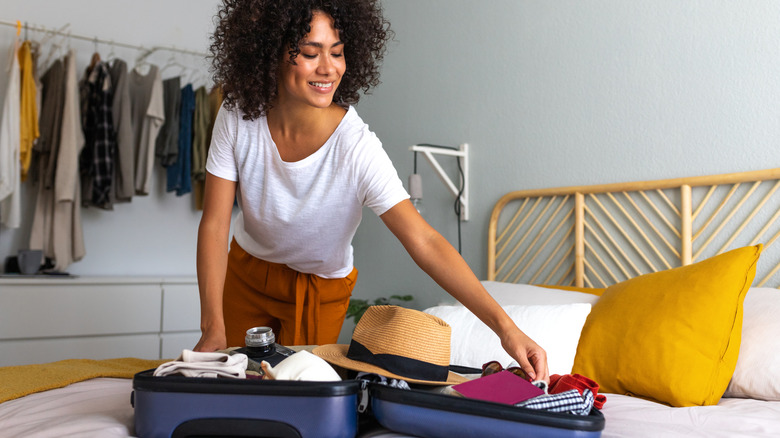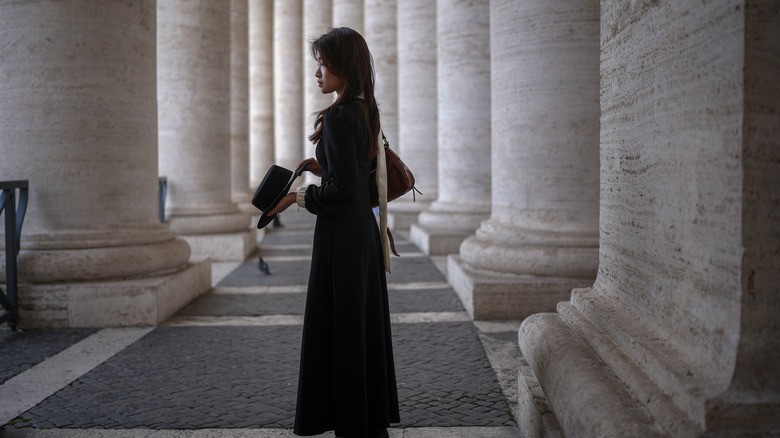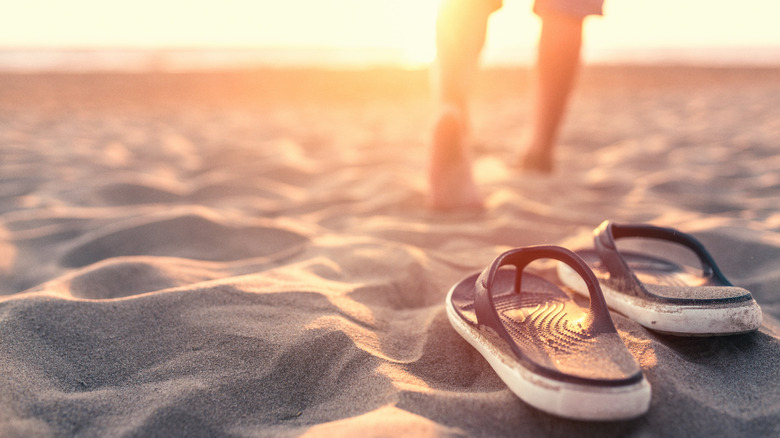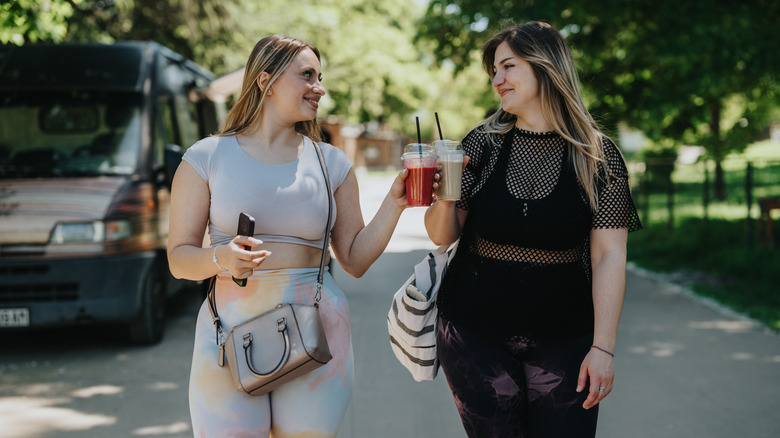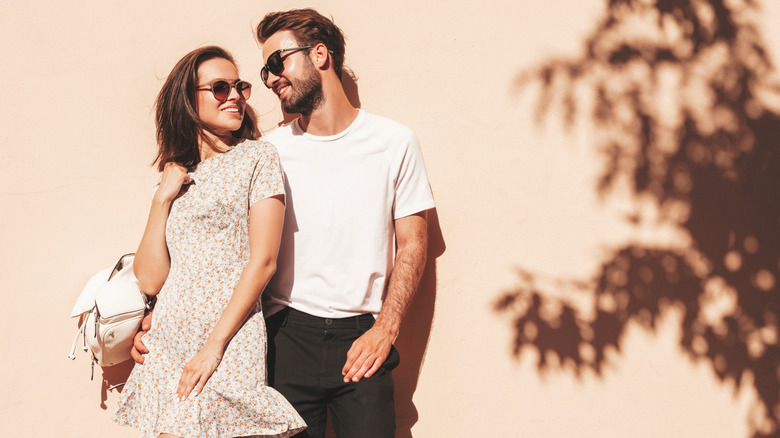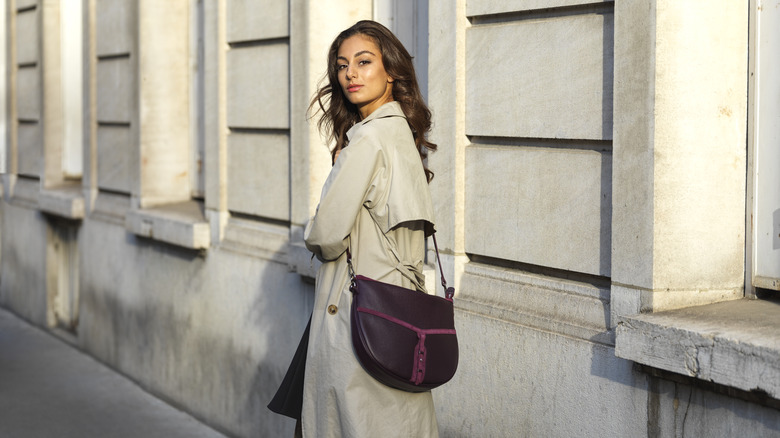Clothing Etiquette Rules Every Tourist Needs To Know Before Packing For A Trip To Europe
Europe is full of so many iconic destinations to explore. You can visit medieval castles, explore ancient ruins, meander through picturesque villages, or dance until the sun comes up in iconic cities like Paris, London, and Rome. There's something for every type of traveler to enjoy, and your packing list will look a bit different depending on which destinations you plan to visit. That being said, there are some basic etiquette rules tourists should adhere to if they want to avoid sticking out like a sore thumb in Europe.
Packing for a European getaway is one of the most exciting parts of the preparation process, but it can also be a little bit daunting. Three of the "Big Four" fashion cities around the world are European — Paris, London, and Milan (with New York being the fourth). The continent is full of fashionable destinations, which can be intimidating if you don't usually spend a ton of time planning your outfits. Some travel experts will tell you that it doesn't matter what you pack, as long as you feel comfortable, but it's also a good idea to try to blend in if you want to avoid being an annoying tourist. Being pegged as a tourist can cause some problems. You may put yourself at risk for petty crimes like pickpocketing and some businesses even attempt to price-gouge travelers from other countries. Any seasoned traveler can attest to how easy it is to spot an American tourist in Europe, which is mostly due to clothing choices.
Keeping a low profile and blending in with the locals is a good idea if you want to avoid attracting unwanted attention. To do so, you should carefully plan your travel wardrobe, respect the local culture, and ensure that you adhere to the unspoken rules of European fashion.
Don't show too much skin when visiting religious sites
Whenever you travel, it's important to be respectful of the local customs. There are some places where showing a lot of skin is frowned upon — particularly those with conservative values or cultures that are strongly influenced by religion. Most European destinations aren't overly conservative, but you should dress modestly when visiting certain religious establishments.
Cathedrals, temples, and other places of worship have some of the most incredible architecture. They are often very ornate, as they were constructed to inspire a sense of reverence in visitors. Whether you're religious or not, they are fantastic places to visit during your trip. Keep in mind that many cathedrals and churches are still used for worship. It's important to dress respectfully when you visit — even if you don't adhere to a particular faith.
As a good rule of thumb, when visiting religious establishments in Europe you should try to cover up from your shoulders to your knees. European summers can be hot, so on the streets you'll see plenty of people in sleeveless clothing and short dresses or skirts. Those outfits are appropriate for walking around town, but not for entering a place of worship. Italy is one example of a place where tourists should be cautious of the clothing they pack. At the Vatican, a modest dress code is strictly enforced. Clothing should not be overly tight or contain any offensive words or images. Opt for something that isn't low cut, and wear long sleeves if possible. If it's hot outside, consider packing a lightweight scarf to wrap around your shoulders when you enter a religious building. A long dress that reaches below the knee or some lightweight trousers are good options.
Ditch the flip-flops
Sandals aren't as common in Europe as they are in some other parts of the world. The casual plastic flip-flops that are popular in the United States during the summer months are particularly ill-advised. In 2024 there were rumors that flip-flops were actually banned on the popular Italian island of Capri. Those rumors turned out to be false, but in Cinque Terre you can receive a hefty fine of over $2,000 if you're caught wearing them on the hiking trails. Casual sandals are appropriate for the beach, and that's pretty much it.
There are plenty of alternatives that you can wear instead of flip-flops. Many cities are extremely walkable, so comfort is going to be key when choosing footwear. In some European cities, like Paris, ankle boots are worn throughout the year. Ballet flats, stylish leather sneakers, and breathable espadrilles are all popular options that keep your toes covered.
If you do prefer sandals, consider opting for something that looks a bit more elevated. A leather sandal with a heel strap and a solid sole with decent traction looks a lot more refined and can be more comfortable and sturdy when you're trying to navigate cobblestone streets. If you're looking for an option that is just as comfortable as your favorite flip-flops or Adidas slides, try Birkenstocks, which are made in Germany and come in a variety of colors and styles. The iconic stylist Tan France has some genius tips on how to avoid looking like a tourist in Europe. "If you truly want to look like you belong in Europe, purchase a pair of handmade leather sandals from a local vendor — they're stylish and make a great souvenir," he advised in a style guide he curated for Trainline.
Athleisure is for workouts, not for city sightseeing
In the United States it's become trendy to wear expensive athleisure for most daily activities. Brands like Lululemon, Athleta, and Alo Yoga are all the rage. It's totally common to see people dressed like they're going to the gym at the grocery store, shopping mall, and even at restaurants. Even if the gym isn't on the daily agenda, many people opt to wear their cute and comfy athletic clothing. In Europe, it's far less common.
Common activewear clothing includes things like leggings, sweatpants, hoodies, and cropped sports bra tops. This casual attire can be extremely comfortable, but it looks a little too casual for most European cities. Unless you're planning on hitting the gym or going on a heart pumping hike, it's best to leave the athleisure at home or packed in your suitcase. You also won't see many people in Europe wearing college branded apparel or jerseys that celebrate sports teams. Even Rick Steves' son says you should leave the sportswear at home.
Just because you aren't in workout clothes doesn't mean you have to dress uncomfortably. A lightweight pair of linen trousers is just as comfortable as a pair of leggings. You can opt for a soft cotton t-shirt, or a sleeveless blouse in place of an athletic top.
Stay cool, but don't wear shorts
Many tourists from the United States are surprised to learn that shorts simply aren't as common in many parts of the world. Even in Latin American countries where temperatures remain warm throughout the year they're not usually worn in big cities. Similarly, when traveling in Europe you won't see a ton of locals wearing shorts unless they're at the beach. "According to France, shorts are not cool, they're revealing," wrote Jenny Hughes in an article published by Frenchly. "Shorts are not comfortable, dresses are comfortable. Shorts are not timeless, they're for the finite amount of time that one spends at the beach, or as a child."
Rick Steves, America's favorite European travel expert, tends to recommend whatever makes one feel comfortable — but even he advises against packing shorts. On his website he wrote, "the cutoff temperature for "hot enough for shorts" is much higher than in the U.S. Especially in southern Europe, women can blend in with the locals by wearing Capri pants or a skirt instead; men can pack a pair of as-light-as-possible pants."
When it comes to staying cool consider opting for lightweight breathable fabrics like cotton or linen, which will make wearing long pants more bearable in the heat. If shorts are a staple in your wardrobe, at least avoid the baggy cargo shorts with tons of pockets. Those are always a sure-fire way to spot an American tourist. A crisp pair of linen shorts that fit well are a much more appropriate choice. If you'd prefer to wear a dress and are worried about chafing, you can always wear a pair of athletic shorts underneath.
Try not to overdress or underdress – aim for understated elegance instead
If you want to blend in with European locals, the key is to find the right blend of comfort and style. There's a reason why the French-chic aesthetic is mimicked all over the world. Europeans manage to achieve a look that is elevated, polished, and effortless all at the same time. If you walk around cities in the United States, the differences between people who are dressed up and dressed casually can be somewhat jarring. You might see someone in baggy sweatpants and an oversized hoodie next to someone in a tight-fitting sequin dress and 6-inch high heels. Europeans tend to dress in the same elegant attire for most events and activities. That being said, it's always better to overdress than to underdress.
Johan Wikström is a menswear content creator who has some great advice on how to dress on your vacation. "Europeans often strike a balance between looking casual and stylish. Even with their everyday attire, people take care to put together outfits that are both comfortable and chic," he wrote in an article published on He Spoke Style. "Many Europeans appreciate classic and timeless fashion. You'll often see people wearing well-tailored clothing, such as blazers, trench coats, and well-fitted trousers. Quality and durability are valued, so investment pieces that last are common."
Europeans are less influenced by trends, so choosing timeless pieces is a good way to blend in. To create the perfect travel capsule wardrobe, you should stick to a neutral color palette and add pops of color through accessories. Choose items that can be mixed and matched to create a variety of outfits to wear for every occasion during your trip to Europe.
